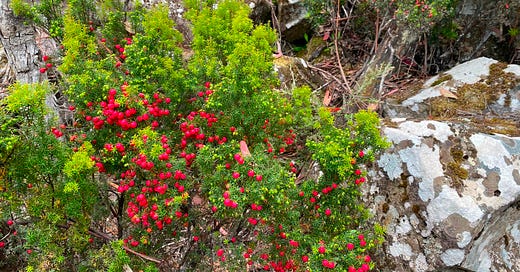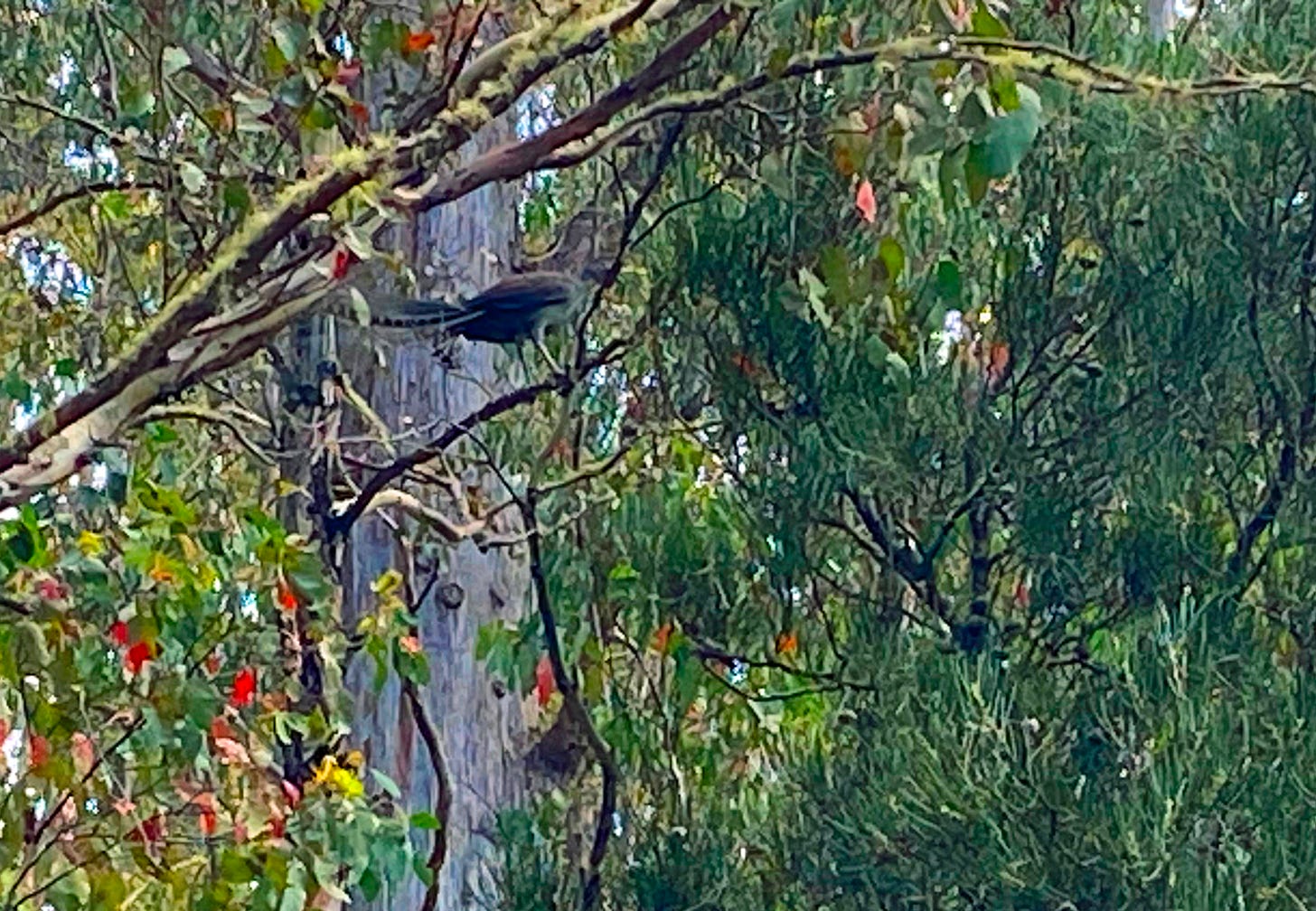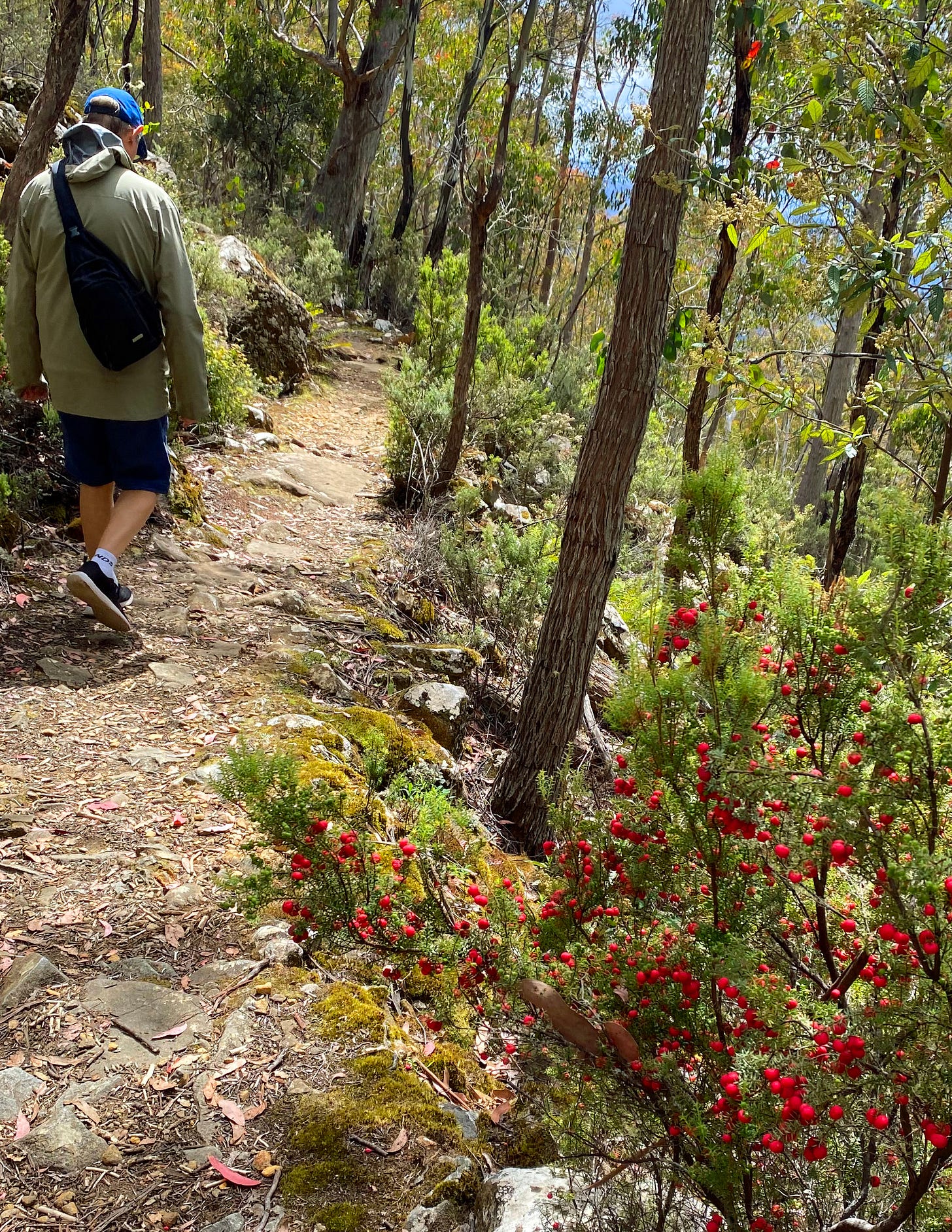I step out onto the deck and breathe in the cool, first-day-of-the-new-year air. Smudgy clouds hang just below the top of the mountain. There is sun on nearby roofs while others remain in shadow. Alan is still in bed asleep.
Red carnation petals are strewn across the deck and I hear a chorus of bird sounds coming from all directions, near and far. I’m glad I had no alcohol last night. It feels good to be alive, to be here to embrace this morning. The first of January — my mother’s birthday.
After Alan emerges and has a coffee we drive up the mountain and park at the Springs. It is cooler here than at home and I am glad I have brought a jacket. We take the Lenah Valley track, to go past the Rock Cabin and Sphinx Rock before doing a loop back via the Shoobridge Track and the Octopus Tree. It takes about 90 minutes and has some uphill sections, which get the heart pumping.
Everyone we meet along the way is cheerful. There are a lot of “Happy New Year” greetings. A young woman and man, two young girls, and an older couple pass us. “Good Morning,” the younger woman says brightly. One of the little girls in the rear, says “Why does everyone say ‘Good morning’, when it must be afternoon by now.” “Indeed,” says the older man.
Alan disappears ahead on the track while I take photographs of the pink mountain berries and the lichen-covered rocks. I am stopped by an urgent loud noise from above, sounding like an animal in distress. I stop and look up to where the sound seems to be coming from. High up in a eucalyptus tree, I see a large lyrebird squawking on a limb near the top of the tree. Not what I was expecting to see, this bird with its graceful long tail, making such a racket. The leaves and branches around him (I’d imagined he was a male) are rustling and moving as a result of his agitation.
After a while, the bird quietens and I continue on my walk but am startled when two smaller lyrebirds dart out of the bush on the lower side of the track about 20 metres ahead of me. They are definitely in a hurry and disappear into the bush above the track in the general direction of the angry-sounding lyrebird up the tree. Ah, perhaps they are errant teenagers being called back by their father …
There are more rocks and pitfalls on the track for a while and I have to watch my footing. I fashion a walking pole from a sturdy stick I find and make my way carefully with my head down. While I am engaged in this slower journey I think back on last night to the small gathering at my dear friend, Kerry’s. After watching the New Year’s Eve fireworks we engage in a ritual we’ve done for a few years now, exchanging our ‘intention words’ for the new year ahead. There is always something valuable for me, both in thinking about guiding words and in hearing the words others choose, and why they do. I’d settled on ‘Love’ (because I’ve decided I need a bit of softening around the edges) and ‘Creativity’ (to ground me) as my words for 2025. Other words I’d considered were ‘Peace’ and ‘Harmony’.
In thinking about the new year ahead I had been interested in a Substack post I’d read about 2025 being a year perhaps suited to making zero intentions. A year to follow synchronicities and find your flow rather than mapping a path beforehand. This appealed to me too … but hey it would have taken away the fun of choosing words.
So here I am writing this Substack and writing about a walk on the mountain, a noisy lyrebird that got my attention, and my intentions for the new year. I open another tab and do a bit of research on lyrebirds. I read that the Superb Lyrebird, which is found on Mt Wellington (kunanyi) “looks like a large brown pheasant. The wings are rufous in colour and the bill, legs and feet are black. The adult male has an ornate tail, with special curved feathers that, in display, assume the shape of a lyre. The tails of females and young males are long, but lack the specialised feather. Females are smaller than males.” (BirdLife Australia) I was right to assume the lyrebird I saw was a male.
Lyrebirds are expert mimics, with both natural and mechanical sounds imitated and joined together. Sounds can include anything heard in the bird’s immediate surroundings, such as chainsaws, car engines, dog barks, and other local native birds. In Aboriginal Dreaming stories, the lyrebird is given the role of the peacemaker in the first great dispute between all creatures: As a reward, the Spirits gave the lyrebird the ability to be the only animal able to communicate with all the other animals.
What I like about the lyrebird is its role as a peacemaker. I’m choosing to see my interaction with this bird as a positive sign for the year ahead. So far, I’m on the right track.







Lovely to join you on your walk, and we definitely need a peacemaker! Bring on the tooting, screeching lyrebirds!!!
Yes I'm taking it as one Lou! Thank you for your comment x